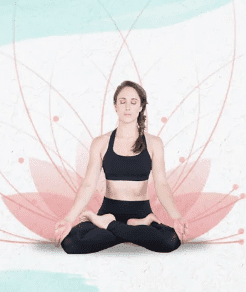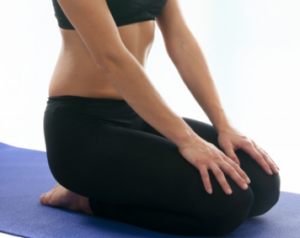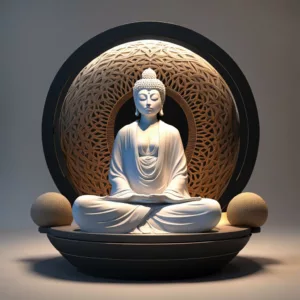
Lotus Pose, or Padmasana, is a cross-legged meditation position with both ankles resting on opposing thighs.
img:arhantayoga.com
Lotus pose is considered relatively difficult for Westerners and non-yoga or non-meditators. Though not so challenging to enter the pose, few can maintain it for longer than a few moments without pain.
A key point: Lotus pose, in Vajrayana meditation, is a power pose of meditation. It circulates the energies back into the body, sealing off looseness and leaks of energy. The posture has a powerful, almost ‘unbreakable’ feeling. In fact, it is also called vajra posture in some cases. (There is also a standing vajra posture which is completely different.)
Secrets of Meditation for Anxiety
Like millions of people, you may have suffered from anxiety for years. Meditation, yoga, peaceful music – it never works. It takes too long, and it’s not stable. Why? Because peace is treated as a cause for freedom, but it’s not – it’s the result. The cause to free yourself from anxiety is completely different.
Click now to Overcome Anxiety for good.
Table of Contents
Lotus Pose: Unusual facts
Here are 3 unusual facts about the Lotus Pose:
- Historical Significance:
- Depictions of Padmasana date back thousands of years, appearing in ancient Indian carvings and artwork.
- It wasn’t just a yoga posture but a preferred sitting position for meditation, religious ceremonies, and even royalty in some cultures.
- Physiological Effects:
- Studies suggest that regularly practicing Lotus can potentially improve blood flow and circulation in the legs and hips.
- This is due to the way the pose stretches and opens the hip flexors and inner thighs, potentially improving blood flow in these areas.
- Symbolic Meanings:
- Beyond its physical benefits, the Lotus Posture holds deep symbolic meaning in various cultures, particularly Hinduism and Buddhism.
- The lotus flower, from which the pose derives its name, symbolizes:
- Purity: The lotus flower emerges from muddy water, representing the potential for spiritual growth despite challenging circumstances.
- Enlightenment: The flower’s perfect bloom signifies the state of awakening and liberation sought in spiritual practices.
- Connection: The lotus flower’s roots are grounded in the mud while its blooms reach towards the sun, representing the connection between the earthly and the spiritual realms.
Lotus Pose overview
| Entity | Description |
|---|---|
| Lotus Pose (Padmasana) | A classic yoga posture named after the lotus flower due to its resemblance. |
| Sanskrit Name | पद्मासन (Padmāsana) |
| Category | Yoga posture, Meditation posture |
| Benefits | * Improved flexibility * Enhanced posture * Promotes meditation * Symbolic significance (purity, enlightenment) |
| LSI Keywords | Yoga posture, Meditation, Flexibility, Core strength, Inner peace, Mindfulness, Pranayama (breathwork), Hatha yoga |
| Related Poses | * Half Lotus Pose (Ardha Padmasana) * Easy Pose (Sukhasana) * Hero Pose (Virasana) |
| Alternatives (for Meditation) | * Seated meditation on a chair * Walking meditation |
| Considerations | * Requires flexibility * Not recommended for beginners * Practice with proper alignment to avoid injury |
| Preparatory Stretches | * Butterfly Pose (Baddha Konasana) * Lizard Pose (Ghutanasana) |
| Tips | * Start with simpler poses and gradually progress. * Use props (cushions) for support. * Practice regularly for improved flexibility. |
Additional Notes:
- Padmasana is a seated posture achieved with the feet placed on top of opposite thighs.
- It holds symbolic meaning in many cultures, representing spiritual growth and enlightenment.
- While beneficial for flexibility and meditation, it’s crucial to prioritize comfort and avoid forcing the pose.
- Alternative poses and modifications are available for those who find Lotus Pose challenging.
Lotus Pose / Padmasana
Ever wondered about the pretzel-like pose yogis effortlessly hold in meditation? That’s the Lotus Pose, also known as Padmasana (Sanskrit: पद्मासन), a classic yoga posture known for its symbolic and physical benefits.
Introduction to Lotus Pose
Padmasana resembles a blooming lotus flower, with the feet placed on top of opposite thighs. While it appears graceful and serene, achieving this pose requires considerable flexibility and practice.
Benefits of Lotus Pose
- Improved Flexibility: Regular practice of Lotus Pose stretches the hips, inner thighs, and ankles, enhancing overall flexibility.
- Enhanced Posture: Holding the pose strengthens the core and back muscles, promoting better posture and alignment.
- Meditation: The crossed-leg position is considered a stable and comfortable seat for meditation, promoting focus and inward awareness.
- Symbolic Significance: In many cultures, the lotus flower represents purity, enlightenment, and spiritual growth. Sitting in Lotus Pose embodies this symbolism for yoga practitioners.
Related terms for padmasana
- Yoga posture
- Meditation
- Flexibility
- Core strength
- Inner peace
- Mindfulness
- Pranayama (breathwork)
- Hatha yoga
Step-by-Step Guide to Lotus Pose
Attaining padmasana comfortably requires patience and gradual progression. Here’s a basic guide:
- Begin seated: Sit on the floor with your legs extended straight in front (Dandasana).
- Bend one knee: Gently bend your right knee and bring the foot towards your hip.
- Position the foot: Place the right foot sole facing upwards on top of your left thigh, as close to your hip crease as comfortably possible.
- Repeat with the other leg: Following the same motion, bend your left knee and position the foot on your right thigh.
- Maintain a straight spine: Keep your back straight and shoulders relaxed throughout the pose.
- Breathe deeply: Focus on slow and deep breaths while holding the pose.
Remember: It’s crucial to prioritize comfort and avoid forcing yourself into the pose. If you experience any pain, gently release the position.
Tips for Beginners
- Start with preparatory stretches: Loosen up your hips, ankles, and inner thighs with gentle stretches before attempting Lotus Pose.
- Use props: A cushion or folded blanket can be placed under your hips to elevate your pelvis and make the pose more accessible.
- Practice regularly: Consistent practice, even for short durations, can gradually improve your flexibility and make the pose more attainable.
Alternatives to Lotus Position
If Lotus Posture feels uncomfortable or out of reach, consider alternative seated postures:
- Easy Pose (Sukhasana): Simply sit on the floor with your legs crossed comfortably.
- Half Lotus Pose (Ardha Padmasana): Position one foot on top of the opposite thigh, keeping the other leg extended.
- Hero Pose (Virasana): Sit back on your heels with your knees bent and feet together.
Lotus Pose: Frequently Asked Questions
1. Is Lotus good for beginners?
While Lotus Pose offers various benefits, it’s not recommended for beginners due to the flexibility required. Starting with simpler seated postures and gradually working towards Lotus Pose is advisable.
2. What are the risks of Lotus posture?
Pushing yourself into the pose forcefully can lead to injuries in the knees, ankles, and hips. It’s crucial to prioritize proper alignment and avoid discomfort.
3. How often should I practice Lotus posture?
Regular practice is beneficial, but prioritize comfort over duration. Start with holding the pose for short periods and gradually increase the time as your flexibility improves.
4. Can I modify Lotus?
Absolutely! Using props like cushions or practicing Half Lotus Pose are great alternatives for those who find the full pose challenging.
5. What are some good stretches to prepare for Lotus Pose?
Yoga poses like Butterfly Pose (Baddha Konasana) and Lizard Pose (Ghutanasana) can effectively stretch the hips and inner thighs, preparing the body for Lotus posture.
Remember, yoga is a journey of self-discovery and exploration. Embrace the process, prioritize your well-being, and enjoy the serenity that Lotus Pose can bring to your practice.

May all beings be happy
May all beings be peaceful
May all beings be safe
May all beings awaken to the light of their true nature
May all beings be free








